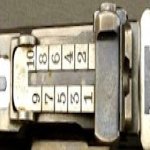OP - you used words that I think have specific meanings - is how I understand them, but I might be in error:
Tangent sight - usually on the rear of barrel - a long arm - hinge at front or back - a slider that moves forward and reverse on that long arm - which lifts or lowers that rear sight for elevation. Some had "steps" in the base part - some were more or less smooth - usually had nominal ranges engraved to set the slider.
Fine Adjustment - I think early part of WWI, various Winchester made P14 were converted by British to be sniper rifles - at the start, these did NOT have scopes - instead the rear sight was re-drilled and tapped and a threaded adjustment for the rear aperture was created - very much is a bonus to have the same serial number on that sight as on the rifle receiver - means that sight originally left the factory with that rifle - was not swapped out. Those P14 sights were usually called "Fine Adjust" - "FA". Was what the early British "snipers" used - above average rifleman, likely above average eye sight, and "fine adjust" rear sights on their rifle for setting elevation. See the book "A Rifleman went to War" - set up behind and above the Allied line - shooting OVER your line at the other guys - when they figured out where firing was coming from, would answer with mortar or artillery. So "shoot accurately" and then "move", seemed to be the game in those days.
Ladder sight - I have seen them both on the tang or rear of receiver - Sharps, P14, M1917 - and out on the barrel - some Winchester 94 carbines - typically were laid down for transport, flipped up to vertical position for shooting. Often had a fixed rear sight to be used in a rush, with that ladder in its laid down position. Some had rear aperture (near to shooter eye), some had "V" notch (out on the rifle barrel) - was likely other types that I have not seen. Has been some well used rifles here - P14 and M1917 - where previous owner filed a "v" notch into top of the rear aperture "battle sight" - so they must have had very good eye-sight to line up a rear "V" sight, so close to their eye.








































































